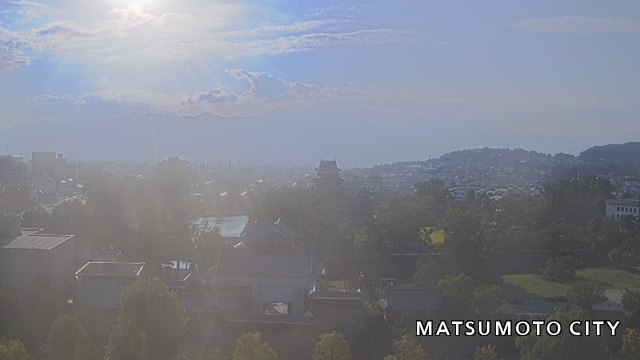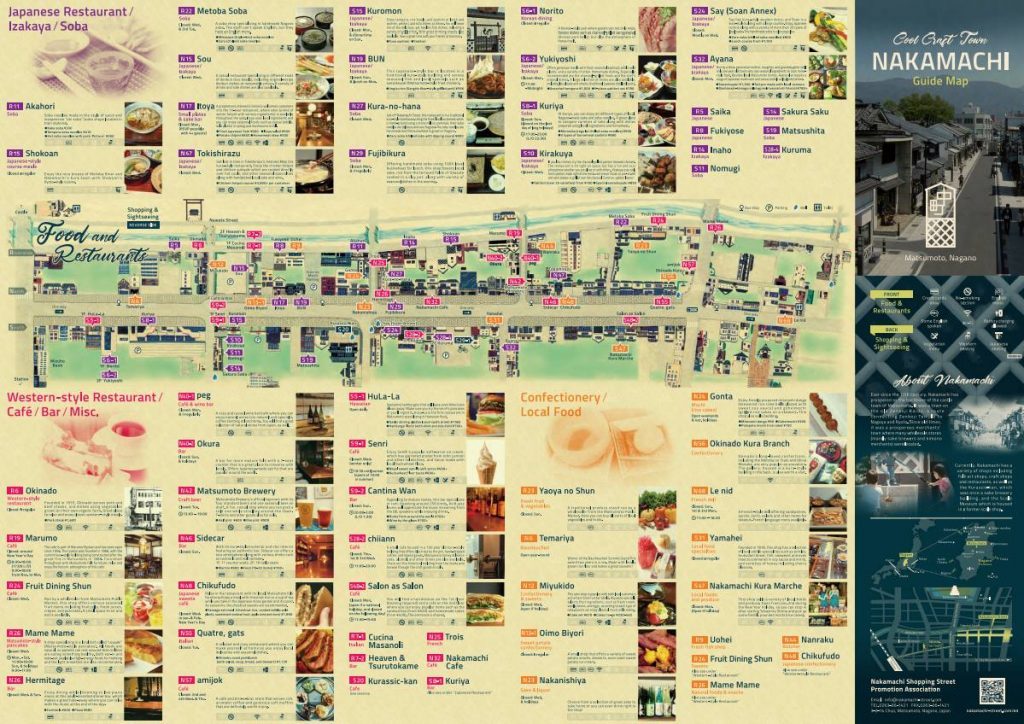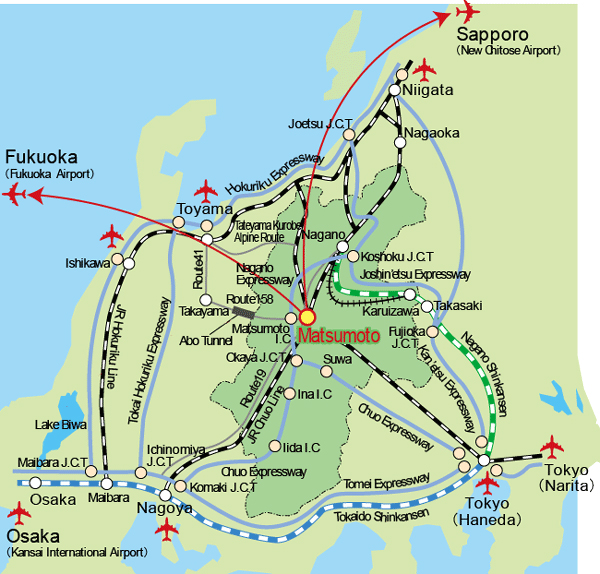Matsumoto Castle
Matsumoto Castle
Japan’s Oldest Castle
Matsumoto Castle (松本城 Matsumoto-jō) in Nagano Prefecture is Japan’s oldest castle. It is also known as the “Crow Castle” (烏城 Karasu-jo) because of its black exterior. Matsumoto Castle is the oldest existing castle in Japan and one of Japan’s premier historic castles.
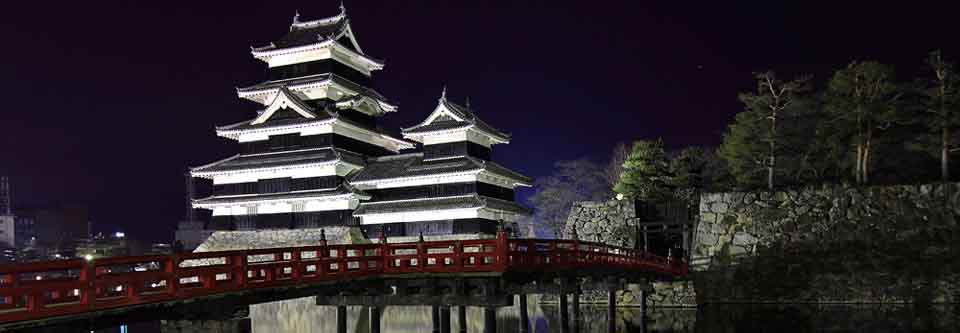
Book Matsumoto Castle Accommodation
About Matsumoto Castle
The second floor of the main keep features a gun museum, Teppo Gura, with a collection of guns, armor and other weapons. All of the guns, armor and other weapons you will see here were the personal collection of Akahane Michishige, a local citizen, who built the collection with his wife Kayoko over a period of more than 30 years. The collection was donated to the city in 1991.
Matsumoto castle is located only a fifteen minute walk north of Matsumoto station (see getting to Matsumoto below). Alternatively, the Town Sneaker Bus departs from in front of Matsumoto Station every 30 minutes and makes a circular trip to all city sights. It costs ¥190 each time you get off. Free bicycles are available daily 8:30am to 5pm at various locations throughout town, including the Matsumoto City Museum next to Matsumoto Castle.
Matsumoto Castle: Admission and Opening TimesRegular admission to the castle is ¥610 for adults, ¥300 for children with discount available for large groups. The castle is open 8:30 AM to 4:30 PM daily (closed 29 Dec – 3 Jan). Tickets include admission to the city museum with artifacts documenting the history of Matsumoto.
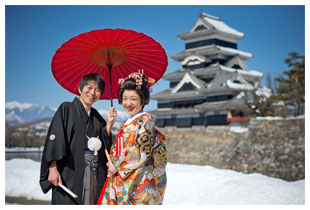 Matsumoto Castle Tours
Matsumoto Castle Tours
If wanting a guided tour of the castle please fill in the form here.
Events at Matsumoto CastleVarious events take place at Matsumoto Castle over the four seasons. These include ice carving, traditional gunnery exhibitions, cherry blossom viewing, taiko festival and moon feasts. It is common to see many newly married couples having their wedding photos taken in the grounds of the castle, especially during Spring.
Get the best Matsumoto accommodation deals here!Matsumoto Highlights
History of Matsumoto Castle
Matsumoto castle’s origins go back to the Sengoku period. At that time Shimadachi Sadanaga of the Ogasawara clan built a fort on this site in 1504 which was originally called Fukashi Castle. In 1550 it came under the rule of the Takeda clan and then Tokugawa Ieyasu.
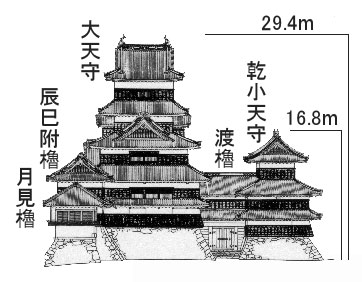
At the time there was already a marketplace on the east side of the secondary citadel, but the area to the west consisted entirely of swampland. Full scale construction of the structure we can now see began in the 1580’s, only Inuyama Castle is older. The Ishikawa family became the daimyo of the area serving Toyotomi Hideyoshi, and it was the Ishikawa’s who promoted and carried out the development of the castle town. The main donjon that dominates the castle was constructed between 1593 and 1594 by Lord Yasunaga, the second daimyo provided by the Ishikawa family.
Ishikawa Norimasa and his son Yasunaga built the tower and other parts of the castle, including the three towers: the keep and the small tower in the northwest, both begun in 1590, and the Watari Tower; the residence; the drum gate; the black gate, the Tsukimi Yagura, the moat, the innermost bailey, the second bailey, the third bailey, and the sub-floors in the castle, much as they are today. They were also instrumental in laying out the castle town and its infrastructure. It is believed much of Matsumoto castle was completed by 1593–94. During the Edo period, the Tokugawa shogunate established the Matsumoto Domain, of which the Matsudaira, Mizuno and others were the daimyo.
For the next 280 years until the abolition of the feudal system in the Meiji Restoration, the castle was ruled by the 23 lords of Matsumoto representing six different daimyo families. In this period the stronghold was also known as Crow Castle (烏城 Karasu-jo?) because its black walls and roofs looked like spreading wings.In 1872, following the Meiji Restoration, the site, like many former daimyos’ castles, was sold at auction for redevelopment. However, when news broke that the keep was going to be demolished, an influential figure from Matsumoto, Ichikawa Ryōzō, along with residents from Matsumoto started a campaign to save the building. Their efforts were rewarded when the tower was acquired by the city government.
In the late Meiji period the keep started to lean to one side. Old pictures clearly shows how the keep looked like then. It was because of neglect coupled with a structural defect, but a lot of people believed the story of Tada Kasuke’s curse.The castle underwent “the great Meiji renovation” between 1903-1913. In 1952 the keep, Inui-ko-tenshu (small northern tower), Watari-yagura (roofed passage), Tatsumi-tsuke-yagura (southern wing), and Tsukimi-yagura (moon-viewing room) were designated as national treasures. It underwent another renovation “the great Shōwa renovation” in the period 1950-1955. In 1990, the Kuromon-Ninomon (second gate of the Black Gate) and sodebei (side wall) were reconstructed. The square drum gate was reconstructed in 1999. These civic efforts have kept Japan’s oldest castle up to date and very popular with tourists from around the world.
Getting to Matsumoto
Matsumoto is located on the JR Shinonoi Line and is easily reached by bus, car or train. It is four stops away from Shiojiri, the “mid-point” of the Chuo Main Line between Tokyo and Nagoya. There is a tourist information center inside the train station.
Train to Matsumoto, Transport to Matsumoto CastleLimited express trains run to Matsumoto from Tokyo’s Shinjuku station. The Super Azusa (スーパーあずさ) makes the run in about 2 1/2 hours. The Azusa (あずさ) makes the journey in about three hours and leave for Matsumoto every hour until 6:00pm.
Taking several local JR trains will cost roughly ¥4000, getting you from Shinjuku to Matsumoto in around 5-6 hours, in which case you’re better off using a bus (see below).
There’s also the option of taking the Nagano Shinkansen Asama (あさま) from Tokyo to Nagano station, then taking the Wide View Shinano (ワイドビューしなの) limited express to Matsumoto.
The Wide View Shinano also runs from Nagoya station, where there are connections with the Shinkansen line (towards Kyoto and Osaka). The run from Nagoya to Matsumoto takes 2 hours on the limited express; local trains are cheaper and take between 4 and 5 hours, depending on the available trains and connections.
All of the above mentioned rail trips are free when using the Japan Rail Pass.
Bus to MatsumotoAlpico and Keio bus companies operate an hourly service between the Keio Highway Bus Terminal in Shinjuku and Matsumoto. The one-way trip takes about 3 hours.
Alpico and Hankyu bus companies operate twice daily between Hankyu Osaka Bus Terminal at Osaka Station and Matsumoto. The one-way trip takes about 5 hours and 30 minutes.
Alpico and Meitetsu bus companies operate every two or three hours between Meitetsu Bus Center at Nagoya Station and Matsumoto. The one-way trip takes about 3 hours and 15 minutes.
Click here to go to Alpico site for timetable and other information.

Transfer to the Shinonoi Line for trains to Matsumoto using a “Shinano” limited express train, which takes 50 minutes, or a local train. Alpico bus takes approximately 80 minutes from the Nagano Station (West Exit) and costs ¥1,000
From Hakuba to Matsumoto & Matsumoto CastleThe easiest way to get to Matsumoto Castle is take the train direct from Hakuba Station. It is 60 kilometres or 1-2 hours by train. Guided tours run from Hakuba during the winter ski season and cost ¥10,000 for adults and ¥8,000 for adults. This includes a stop at the Daio Wasabi (Horseradish) Farm or Shinshu Winery.
By Car to Matsumoto & Matsumoto CastleFour kilometres (app. 15 minutes) from the Matsumoto IC (see map below)
Book Matsumoto Rental Cars
Want the freedom of a car while you are in Matsumoto or getting around Japan? Get the best car deals by clicking and checking the deals below!
Matsumoto Maps
Matsumoto Castle, Japan’s oldest castle – a National Treasure with 400 years of history. Find Matsumoto Castle accommodation, maps, transport & webcams. Find us at https://matsumotocastle.com



